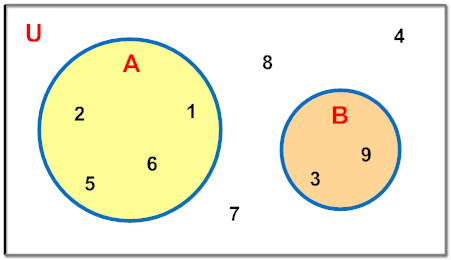What are the special symbols and language I use when I work with sets?
🧠 Lesson Overview
-
Grade: 6
-
Subject: Mathematics
-
Theme: Disjoint Sets
-
Focus Question: What are the special symbols and language I use when I work with sets?
-
Duration: 1 hour
-
Objectives:
-
Name and list members in the intersection or union of two sets.
-
Define “disjoint sets.”
-
🔎 5E Lesson Plan
1. Engage (10 minutes)
Activity: Set Sort and Compare
-
Present students with two different bags (real or virtual) containing labeled cards:
-
Bag A: {apple, banana, orange}
-
Bag B: {carrot, potato, cabbage}
-
-
Ask:
-
What do you notice about the items in both bags?
-
Are there any items that appear in both bags?
-
-
Guide students to conclude there are no common elements → lead into the concept of disjoint sets.
STEM Integration: Technology — Use an online Venn diagram simulator (e.g., mathisfun.com) to drag and drop items interactively.
2. Explore (10 minutes)
Activity: Hands-On Set Building
-
In small groups, students receive two sets of cards with mixed elements (numbers, letters, or objects).
-
Task:
-
Create two sets that intersect (e.g., Set X: {1, 2, 3}, Set Y: {3, 4, 5})
-
Then create two disjoint sets (e.g., Set A: {a, b}, Set B: {x, y})
-
-
Students draw Venn diagrams to represent these relationships.
Differentiation:
-
Tier 1: Teacher support with word cards and visual cues.
-
Tier 2: Moderate scaffolding with guiding questions.
-
Tier 3: Independent creation of set examples with symbols.
3. Explain (15 minutes)
Mini-lesson:
-
Define:
-
Set: a group of objects/elements.
-
Union (∪): all elements from both sets.
-
Intersection (∩): common elements.
-
Disjoint sets: sets with no elements in common.
-
-
Introduce symbols:
-
∩ = intersection
-
∪ = union
-
∅ = empty set
-
-
Use board/visual to show:
-
Set A = {1, 2, 3}, Set B = {4, 5, 6}
-
A ∩ B = ∅ → Disjoint Sets
-
-
Guide students in recording definitions and drawing examples.
STEM Integration: Math Language + Logical Thinking (Computational Science: Classifying/Grouping Data Sets)
4. Elaborate (15 minutes)
Activity: STEM Challenge – Sorting Data
-
Scenario: Students are software designers building a filter for a streaming platform. They must:
-
Create two sets of user preferences (e.g., Set A: {Action, Sci-Fi}, Set B: {Romance, Drama})
-
Determine if the sets overlap or are disjoint.
-
Represent them using Venn diagrams and write:
-
A ∩ B = ?
-
A ∪ B = ?
-
-
Differentiation:
-
Visual learners: Use color-coded diagrams.
-
Kinesthetic learners: Use set circles with physical cut-out images.
-
Advanced learners: Add a third set and analyze.
5. Evaluate (10 minutes)
Three-Tier Evaluation Activity:
| Tier | Activity | Evaluation Focus |
|---|---|---|
| 1 | Match sets using cut-outs or visuals to identify if they are disjoint, overlapping, or equal | Recognize disjoint sets visually |
| 2 | Given Set A and Set B, write A ∪ B and A ∩ B. Indicate if the sets are disjoint | Apply union and intersection correctly |
| 3 | Write a real-life example of disjoint sets (e.g., types of animals vs. types of vehicles) and represent it with a labeled Venn diagram | Apply understanding to real-world context |
✍️ Summary / Exit Ticket (Wrap-up)
-
Ask: “What does it mean if two sets are disjoint?”
-
Students write their own sentence using the word disjoint and draw a quick Venn diagram of disjoint sets.
📚 Materials & Resources:
-
Venn diagram chart
-
Cut-out set items (images or words)
-
Markers, chart paper, or interactive whiteboard
-
Tablets/laptops (if available) for online Venn simulation



Reading ahead of u miss
ReplyDeleteHi miss doing the work
ReplyDeleteHi miss...Way ahead of you. The activities are fun❤️❤️❤️❤️
ReplyDeleteHI miss its Paige these activity are fun
ReplyDeleteHi miss i do some activity are so fun
ReplyDelete